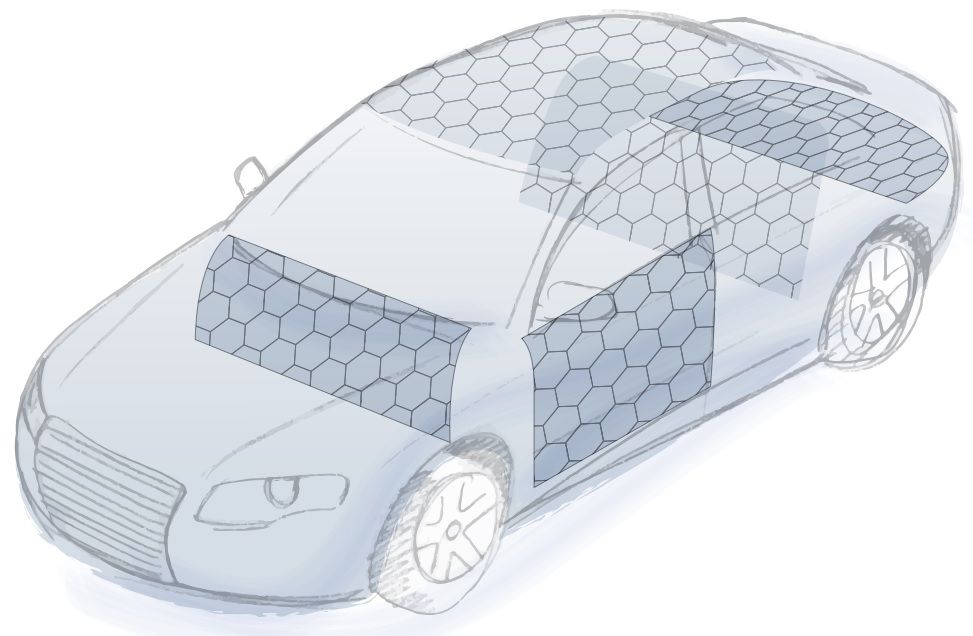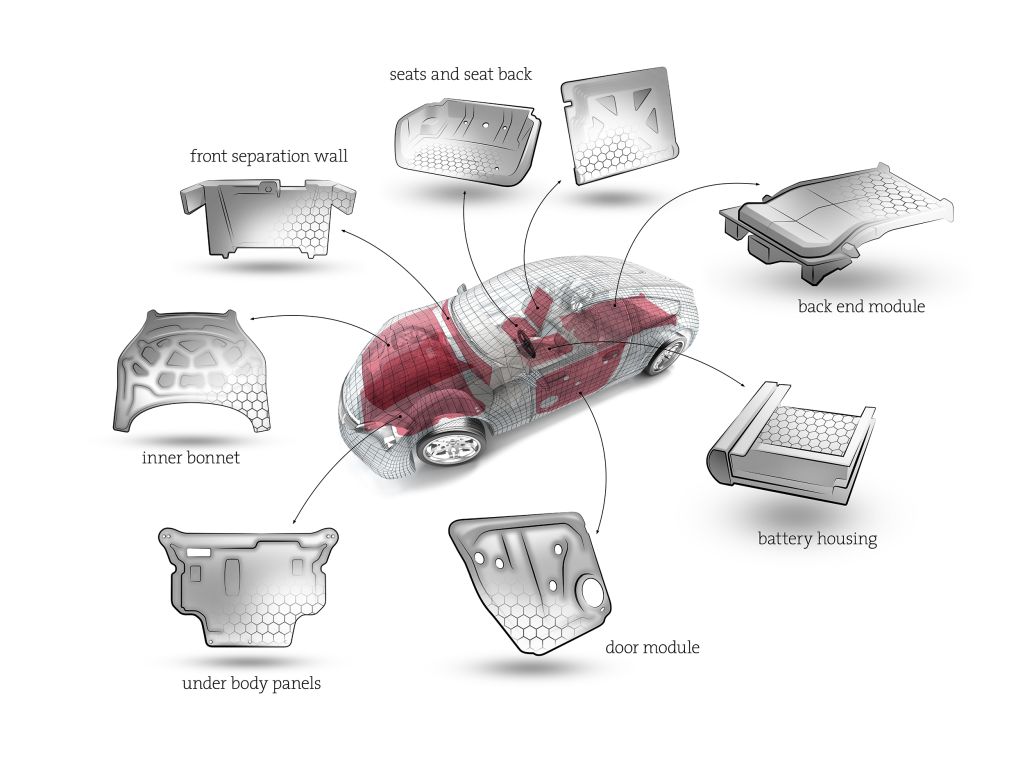More than a filling!

Offering lightweight solutions for many different interior parts to the automotive industry, ThermHex says that its honeycomb sandwich is capable of delivering over 80% weight and cost savings.
When it comes to optimising the efficiency of materials and energy, our learning from mother nature has a long history. In the 17th century Galileo discussed the resistance of hollow solids and how bones of birds and many stalks are light and very resistant to bending and breaking.
Taking inspiration from structures that have stood the test of time with high levels of efficiency, honeycomb technology is inspired by the hexagonal shape of honeybee combs. By using the hexagonal geometry an area can be structured with the least amount of material, saving resources and weight.
Sandwich construction played a key role in the early innovation of transport, being used in the 1830s by Robert Stephenson in the construction of trains and in 1915 by Hugo Junkers. He patented sandwich construction with honeycomb cores for the first modern aircraft.
Today, honeycomb sandwich construction technology can be found across a variety of applications ranging from the automotive to packaging industries, space to aerospace, from swimming pools to furniture. EconCore and ThermHex Waben, specialists in honeycomb technologies for lightweight sandwich panels, have optimised the cost-efficient production technology for the past 17 years, and increasing interest from new customers has enabled the companies to recently open an office in the USA.
Sustainable contributions
In an ever increasingly sustainability-conscious world, sandwich construction with the patented honeycomb core has gained in popularity as it saves resources and minimises environmental impacts; with an added benefit of saving on production costs by reducing the amount of waste materials.

ThermHex has had an increase in automotive and transportation orders for exterior body panels and interior components over recent years. Its polypropylene honeycomb board can be found in many automotive interiors, including the elevated roofs of Volkswagen and Ford campervans, the trunk floor of the Hyundai Creta and trunk cover of the Toyota Prius PHV. The polypropylene core parts for the Creta are produced in a one-step compression mould process with a finished edge closure and a living hinge.
The polypropylene honeycomb produced in a continuous production line by ThermHex offers lightweight solutions for many different interior parts. They provide automotive body panel stiffening as well as energy absorption through damping and crash performance. It has become a trusted material for premium automotive manufacturers, being found e.g. in the Maserati Ghibli and Jaguar F-Type.
Polypropylene (PP) honeycomb can also be combined with other materials. ThermHex use their PP honeycomb with PP-glass fibre skins to create low weight, high rigidity automotive structural parts. The technology was used to create a honeycomb composite fender for a Porsche 550 spider replica. The honeycomb construction used for such a project had a 3mm cell size, leading to a perfect surface quality.
Similarly to the wider automotive industry, the choice of material is just as important for caravans, where plywood has traditionally been used. However composite honeycomb constructions can replace this and be used for floors, roofs and walls.
Polypropylene honeycombs offer a lightweight alternative to plywood. Also plywood faces severe problems in the rain, becoming heavy and potentially disintegrating when wet. Polypropylene honeycomb cores, on the other hand, maintain the structure and mechanical properties even when wet.
“Sandwich structures have found their place for many decades within lightweight structures, their economic advantages proving crucial in a wide range of applications,” says ThermHex’s CEO, Dr Jochen Pflug. “Across the automotive industry, sustainability is becoming an increasingly important factor.
“The ThermHex honeycomb production technology, which we develop further together with our mother company EconCore, provides lightweight, high rigidity materials which are more environmentally-friendly than other competitor materials. Using cost efficient and environmentally-friendly materials doesn’t mean that companies need to compromise on performance.”
By making the switch to sandwich construction with honeycombs, caravan producers have been able to reduce the total weight by up to 55kg. The use of polypropylene honeycomb also reduces condensation, improves durability and installation for Grade III compliance when compared to the more traditional plywood.
By being Grade III compliant caravans are able to remain at a steady 20°C inside whilst the outside temperature can be as low as -15°C, and the sandwich construction helps to achieve this.
There are many honeycomb composite structures available, made from a variety of materials including paper, polypropylene and recycled PET. Despite all being similar in structure technical comparisons can still be drawn between the various sandwich constructions.

When comparing, for example, a 16mm paper honeycomb + PUR-GF mat sandwich construction with a 12mm polypropylene honeycomb + GF-PP UD tapes in a short span (220mm) flexural test, the paper honeycomb sandwich exhibited a maximum load (in cross direction) of 740 N. However, the polypropylene honeycomb sandwich can withstand a greater maximum load in this direction of 780N.
Similar results can be shown by repeating the test in transverse direction. The paper honeycomb exhibited a maximum load (machine direction) of 580N, only marginally lower than the polypropylene’s 590N although the latter is thinner.
Finally, when comparing the areal weight of the two sandwich constructions the paper honeycomb was heavier, weighing 4,280g/m², over a kilogramme per square metre heavier than the polypropylene honeycombs (3,240g/m²).
Despite the lower thickness the PP HC + GF-PP UD tape sandwich has a higher bending stiffness in both directions than the paper HC + PUR-GF mat sandwich.
When it comes to sustainability the sandwich construction made of PP honeycomb core with PP-GF skins has even more advantages over the paper honeycomb with PUR-GF skins. Due to the irreversibly thermosetting PUR resin the latter is not recyclable while the first can be easily recycled.
Polypropylene and recycled PET (RPET) honeycomb constructions clearly have their advantages over not only more traditional materials, but also other sandwich constructions. As the automotive industry looks ahead to a more sustainable future, reducing the amount of virgin raw materials results in maximum resource efficiency.
Shape and structure
Thanks to their excellent mechanical properties due to both the hexagonal honeycomb structure and the choice of sandwich material, they offer high weight specific stiffness and strength. Compared to a monolithic panel in a sandwich construction, the core density can be reduced by 20 times. This can deliver a cost saving of over 80% when compared to a monolithic material.
A big advantage for any business is cost-saving, the patented ThermHex production technology line allows fast, continuous in-line production of honeycomb cores and panels leading to a maximum cost reduction.
Within the automotive industry currently, ThermHex’s polypropylene honeycomb cores are being used for applications such as body panel stiffening and for other lightweight solutions within vehicle interiors including trunk floors. This is because they are an easily recyclable, sustainable solution.
As part of the global effort to meet net zero emission objectives, sustainable materials must become more widespread in a host of industries. This can be achieved through providing manufacturers with sustainable alternatives that won’t compromise on mechanical properties.








